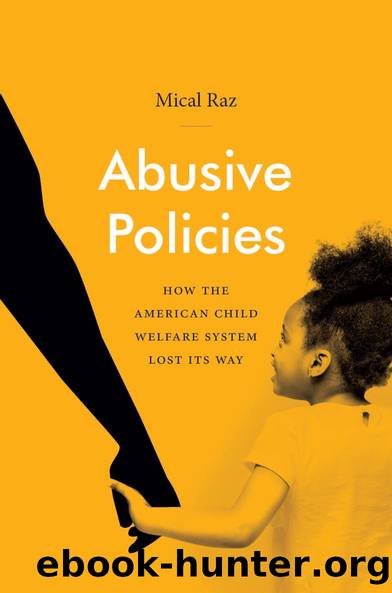Abusive Policies by Mical Raz

Author:Mical Raz [Raz, Mical]
Language: eng
Format: epub
ISBN: 9781469661216
Barnesnoble:
Publisher: The University of North Carolina Press
Published: 2020-12-18T00:00:00+00:00
CHAPTER FIVE
Child Abuse in Black and White
Two Moral Panics in the 1980s
In the 1980s, policy makers, child welfare experts, and the popular media expanded and mobilized child abuse as a political concept in unprecedented ways, transforming it into both a public threat and a cultural phenomenon. Not only did this development fail to further the safety of children, but it also caused distinct harm to thousands of children and their parents. As children were increasingly identified as potential victims of sexual exploitation, parents became convinced that ritual sexual abuseâa term used to describe child sexual abuse as part of a system of satanic worshipâwas rampant in day cares throughout the country.1 A large-scale study completed in 1995 found no corroborating evidence to support the existence of this form of sexual abuse.2 Still, the media uncritically adopted this sensationalist discourse of mass child sexual abuse outside the home within this ritualistic context.3 As a result, lengthy, expensive trials involving childrenâs testimony unfolded over the decade.
Many of the same early Parents Anonymous supporters became prominent activists in this movement, including psychiatrist Roland Summit, social worker Kathleen (Kee) MacFarlane, and Los Angeles assistant district attorney Jean Matusinka. As concerns over the psychological effects of child sexual abuse rose, an inverse correlation developed, in which psychological distress among adult women was reinterpreted as evidence of childhood sexual abuse. With the assistance of overzealous therapists, many women alleged that their own parents had sexually abused them as children. This gave rise to criminal and civil lawsuits over ârecoveredâ memories, and what has been critically termed as the âchild abuse industry.â The families alleging sexual abuse of their children, as well as the women who laid claim to newly remembered past abuse, were predominantly white and middle class.
Concurrently, a panic over crack cocaine use in predominantly poor African American pregnant mothers emerged, as prosecutors and state legislators sought to use child abuse statutes to confine and punish pregnant women, particularly women of color, who were using drugs. While many of these attempts were unsuccessful, South Carolina became the first state to uphold the argument that pregnant women who used drugs could be guilty of child abuse.4 In an era when addiction treatment was scarce, poverty was rampant, and medical care was often inaccessible, these interventions threatened a vulnerable population with criminal prosecution rather than offering systemic solutions.5
In these two historical episodes, child welfare and specifically child abuse were weaponized as political tools. As a result, the safety and well-being of the children involved were severely compromised, as policy makers and child welfare experts mobilized intrusive interrogations and separations from families and communities as âprotectiveâ solutions to a social pandemic. Furthermore, I argue that this focus on perceived moral threats to children, rather than on the myriad of ways in which children were rendered vulnerable by policies that failed to address their material needs, was a missed opportunity to improve the well-being of children throughout the country. A focus on child abuse was, I will show, a
Download
This site does not store any files on its server. We only index and link to content provided by other sites. Please contact the content providers to delete copyright contents if any and email us, we'll remove relevant links or contents immediately.
Cecilia; Or, Memoirs of an Heiress — Volume 1 by Fanny Burney(32379)
Cecilia; Or, Memoirs of an Heiress — Volume 3 by Fanny Burney(31754)
Cecilia; Or, Memoirs of an Heiress — Volume 2 by Fanny Burney(31721)
The Great Music City by Andrea Baker(31090)
We're Going to Need More Wine by Gabrielle Union(18908)
All the Missing Girls by Megan Miranda(15405)
Pimp by Iceberg Slim(14222)
Bombshells: Glamour Girls of a Lifetime by Sullivan Steve(13930)
Talking to Strangers by Malcolm Gladwell(13137)
Norse Mythology by Gaiman Neil(13134)
Fifty Shades Freed by E L James(13125)
For the Love of Europe by Rick Steves(12365)
Crazy Rich Asians by Kevin Kwan(9128)
Mindhunter: Inside the FBI's Elite Serial Crime Unit by John E. Douglas & Mark Olshaker(9109)
The Lost Art of Listening by Michael P. Nichols(7362)
Enlightenment Now: The Case for Reason, Science, Humanism, and Progress by Steven Pinker(7087)
The Four Agreements by Don Miguel Ruiz(6544)
Bad Blood by John Carreyrou(6479)
Weapons of Math Destruction by Cathy O'Neil(6087)
